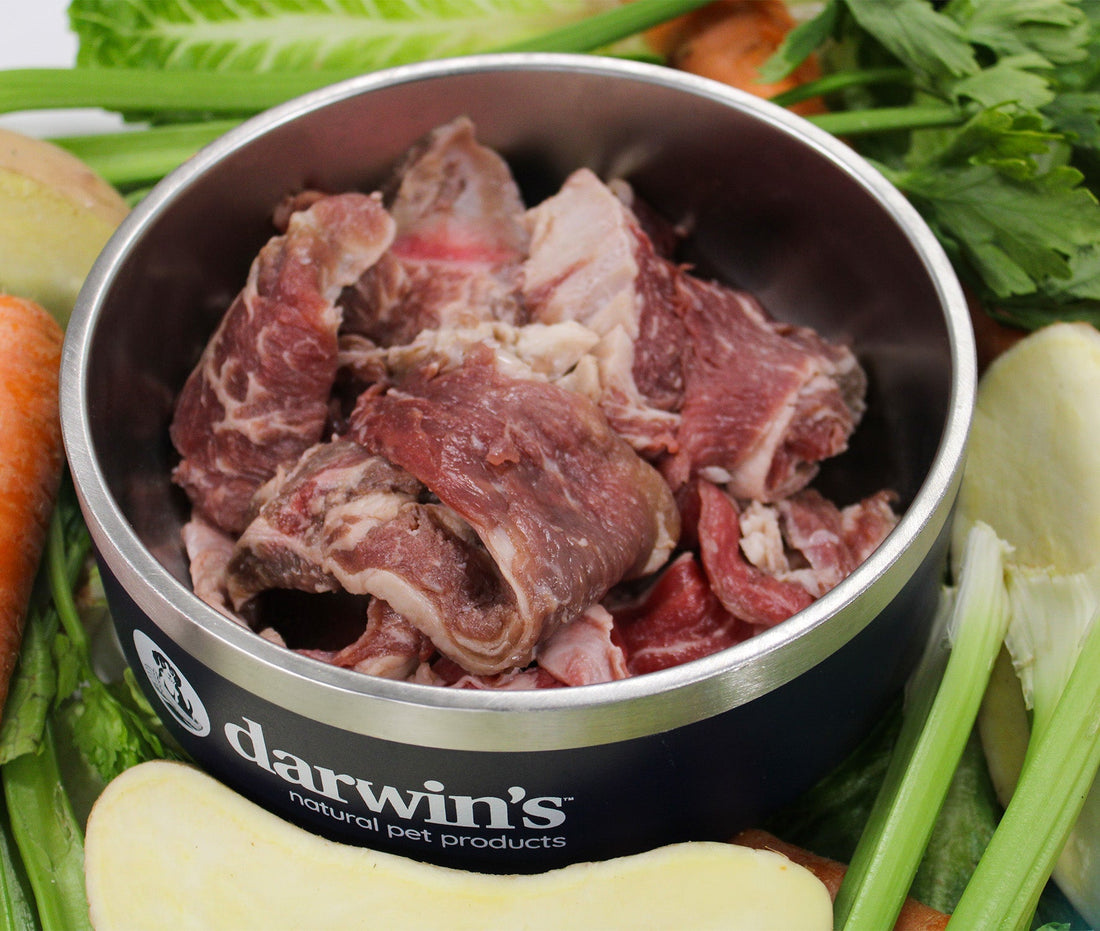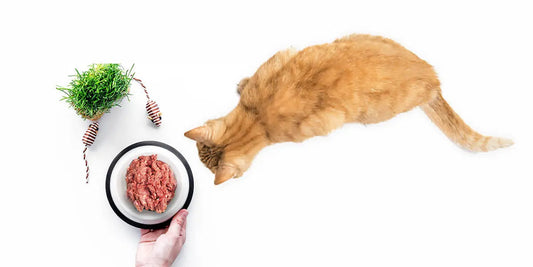
Raw or Cooked Meat for Dogs: A Guide
Written by Darwin's
There isn’t a “one size fits all” approach to pet nutrition. Each pet is unique and may have unique needs. Though we often hear the debate between raw and cooked pet food, the real nutritional differences are between fresh food and processed food.
Whether you feed raw food, like Darwin’s, or cooked food, use these tips to help you find the best diet possible for your unique pet.
- Look for food that uses high-quality, nutrient-dense ingredients.
- Use AAFCO guidelines to ensure meals are complete and balanced.
- Make sure meals are prepared in a way that doesn’t deplete or damage nutrients.
- Don’t let food go stale! Nutrients deplete as ingredients age, so it’s important to feed your pet the freshest food possible, closest to the meals’ manufactured date.
The debate between cooked and raw, fresh and processed, comes down to how you apply our third principle. For those who advocate feeding fresh food, the heavy heat and processing commercial dry foods undergo result in significant destruction of the nutrients found in the food. This typically requires the nutrients to be added back chemically (resulting in less absorbability).
What's the Buzz Surrounding Raw Feeding For Dogs?
Feeding a raw diet to dogs, also known as "raw feeding," is a dietary approach that involves giving dogs uncooked, whole foods like raw lamb dog food or other raw meats, bones, fruits, and vegetables. People choose this diet because they believe it offers benefits like a more natural diet, improved coat and skin, better dental health, better digestion, increased energy, and smaller, firmer stools. However, it has potential drawbacks, including nutritional imbalance, food safety concerns, choking hazards, cost, and potential health risks.
Raw food advocates contend that even light cooking of fresh food compromises the nutrients. Detractors claim that feeding raw increases the risk of introducing pathogens like salmonella and E.coli.
There may be some truth to both statements, but the question comes down to what degree these trade-offs occur? Most credible pet food experts would agree that a healthy dog’s digestive system is well-equipped to deal with normal amounts of bacteria, etc. that may be present in raw meat. According to many of these same experts, however, light cooking of meals (sufficient to destroy any pathogens) causes’ only minimal damage to even the most heat-sensitive nutrients.
So there’s no compelling reason to pick one approach over the other. Instead, the decision should be made on a case-by-case basis. The general rule that may be applied is that the less processing that is done to the food, the better. And for most dogs, that is no processing at all (i.e., raw).
Consulting with a veterinarian or a veterinary nutritionist is essential before starting a raw diet for your dog, and proper education on safe preparation and feeding is crucial. Regular monitoring is necessary to ensure your dog's health remains optimal on this diet.
Isn't it in a Dog's Nature to Crave Raw Meat?
Dogs naturally have a preference for raw meat due to their carnivorous history, but they have adapted to various diets. While some dogs may readily enjoy raw meat, others may need time to adjust or may not have a strong preference for it. It's crucial to ensure that a raw diet is nutritionally balanced and prepared correctly to meet a dog's dietary needs. If you're considering a raw diet for your dog, consult a veterinarian or nutritionist for guidance on a safe and balanced transition.
Benefits of Preparing Cooked Dog Food
Preparing cooked dog food provides enhanced safety by eliminating the risk of bacterial contamination from raw meat, extends shelf life, allows personalized dietary choices, improves digestibility, eases the transition from commercial kibble, and offers variety, convenience, and better nutrient absorption. Pet nutrition consulting is vital for balanced homemade dog meals tailored to specific nutritional needs.
Downside of Cooked Dog Food
The drawbacks of cooking dog food include the time and effort required, potential higher costs, the challenge of maintaining nutritional balance, shorter shelf life, the risk of preparation mistakes, possible difficulties in transitioning dogs to homemade meals, the necessity of consulting with a veterinarian or nutritionist for balanced recipes, and the importance of maintaining proper food safety and hygiene practices. Weighing these factors against the benefits is crucial when considering homemade dog food.
Having said that, there are some dogs with sensitive digestive systems that don’t handle raw food very well, and find cooked food easier to break down. And other dogs with compromised immune systems (or who live with people with compromised immune systems) for whom the risk of illness from pathogens is real. And still, other dogs just prefer their meals cooked, for whatever reason. For those dogs, lightly cooking the food is the best approach.
Surveys from Darwin’s customers indicate that about a third cook their meals for their pets, and two-thirds feed raw. Both groups see dramatic improvements versus commercial kibble, and neither group reports any health problems resulting from their choice.
So when making a choice, don’t get too fixated on the issue of raw or cooked. If you’d feel more comfortable lightly cooking your pet’s meals, go right ahead. The important thing is to feed fresh food, whether raw or cooked and try to minimize the use of heavily processed kibble.
What to Consider When Opting for a Raw Diet?
When opting for a raw diet for your dog, consider essential factors for your dog's diet and health. Ensure a balanced diet with vital amino acids and fatty acids. Consult a veterinarian or nutritionist as a responsible pet owner to create a suitable and age-appropriate plan. Prioritize food safety, account for potential costs and time, and be aware of local regulations and ethical concerns. Your dog's health should guide your choice of a raw diet.
Try Raw Pet Food Now
Want to experience the benefits of raw pet food for yourself? Sign up for our special introductory offer for new customers today. Our complete and balanced raw dog food contains 75 percent meat and 25 percent vegetables, while our raw cat food contains 100 percent meat. Darwin’s affordable dog food uses only carefully sourced human-grade ingredients, and the food contains no grains, fillers, steroids, hormones, by-products, or artificial ingredients. For added convenience, meals are delivered right to your door. Simply thaw and serve—and watch your pet’s energy levels increase and their health improve. Try Darwin’s pet food now.
SOURCES:
- https://apupabove.com/blogs/all/freshly-cooked-vs-raw-food-diets-for-dogs#:~:text=Gently%20cooked%20fresh%20food%20is,any%20more%20than%20you%20would!
- https://ricksdogdeli.com/blog/raw-or-cooked-meat-for-dogs/
- https://vethelpdirect.com/vetblog/2022/01/13/cooked-versus-raw-foods-for-dogs/
- https://www.yourpurebredpuppy.com/health/articles/feeding-raw-vs-cooked-dog-food.html
- https://www.whoanelly.com.au/blog/cooked-vs-raw


